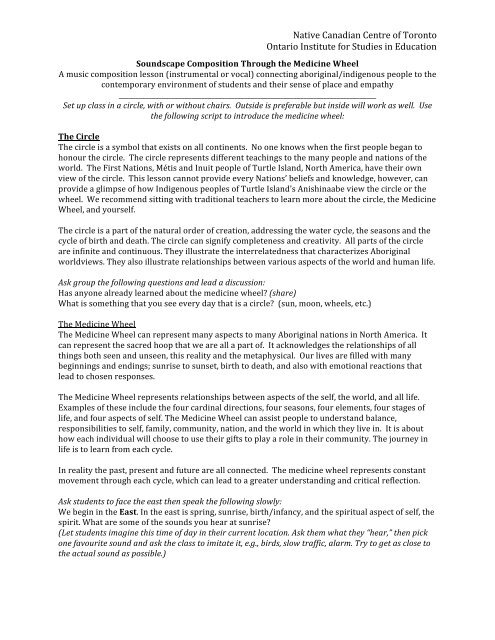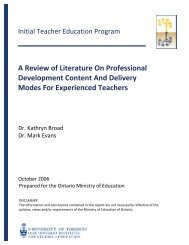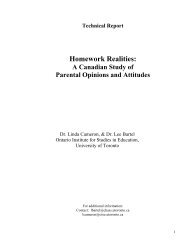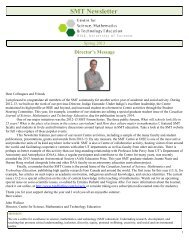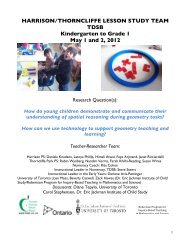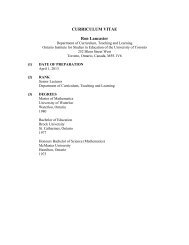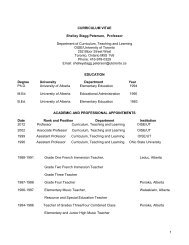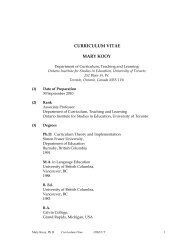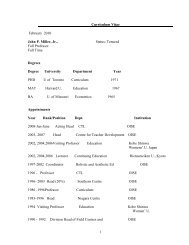Soundscape Composition Through the Medicine Wheel
Soundscape Composition Through the Medicine Wheel
Soundscape Composition Through the Medicine Wheel
You also want an ePaper? Increase the reach of your titles
YUMPU automatically turns print PDFs into web optimized ePapers that Google loves.
Native Canadian Centre of Toronto Ontario Institute for Studies in Education <strong>Soundscape</strong> <strong>Composition</strong> <strong>Through</strong> <strong>the</strong> <strong>Medicine</strong> <strong>Wheel</strong> A music composition lesson (instrumental or vocal) connecting aboriginal/indigenous people to <strong>the</strong> contemporary environment of students and <strong>the</strong>ir sense of place and empathy ______________________________________________________________________________ Set up class in a circle, with or without chairs. Outside is preferable but inside will work as well. Use <strong>the</strong> following script to introduce <strong>the</strong> medicine wheel: The Circle The circle is a symbol that exists on all continents. No one knows when <strong>the</strong> first people began to honour <strong>the</strong> circle. The circle represents different teachings to <strong>the</strong> many people and nations of <strong>the</strong> world. The First Nations, Métis and Inuit people of Turtle Island, North America, have <strong>the</strong>ir own view of <strong>the</strong> circle. This lesson cannot provide every Nations’ beliefs and knowledge, however, can provide a glimpse of how Indigenous peoples of Turtle Island’s Anishinaabe view <strong>the</strong> circle or <strong>the</strong> wheel. We recommend sitting with traditional teachers to learn more about <strong>the</strong> circle, <strong>the</strong> <strong>Medicine</strong> <strong>Wheel</strong>, and yourself. The circle is a part of <strong>the</strong> natural order of creation, addressing <strong>the</strong> water cycle, <strong>the</strong> seasons and <strong>the</strong> cycle of birth and death. The circle can signify completeness and creativity. All parts of <strong>the</strong> circle are infinite and continuous. They illustrate <strong>the</strong> interrelatedness that characterizes Aboriginal worldviews. They also illustrate relationships between various aspects of <strong>the</strong> world and human life. Ask group <strong>the</strong> following questions and lead a discussion: Has anyone already learned about <strong>the</strong> medicine wheel? (share) What is something that you see every day that is a circle? (sun, moon, wheels, etc.) The <strong>Medicine</strong> <strong>Wheel</strong> The <strong>Medicine</strong> <strong>Wheel</strong> can represent many aspects to many Aboriginal nations in North America. It can represent <strong>the</strong> sacred hoop that we are all a part of. It acknowledges <strong>the</strong> relationships of all things both seen and unseen, this reality and <strong>the</strong> metaphysical. Our lives are filled with many beginnings and endings; sunrise to sunset, birth to death, and also with emotional reactions that lead to chosen responses. The <strong>Medicine</strong> <strong>Wheel</strong> represents relationships between aspects of <strong>the</strong> self, <strong>the</strong> world, and all life. Examples of <strong>the</strong>se include <strong>the</strong> four cardinal directions, four seasons, four elements, four stages of life, and four aspects of self. The <strong>Medicine</strong> <strong>Wheel</strong> can assist people to understand balance, responsibilities to self, family, community, nation, and <strong>the</strong> world in which <strong>the</strong>y live in. It is about how each individual will choose to use <strong>the</strong>ir gifts to play a role in <strong>the</strong>ir community. The journey in life is to learn from each cycle. In reality <strong>the</strong> past, present and future are all connected. The medicine wheel represents constant movement through each cycle, which can lead to a greater understanding and critical reflection. Ask students to face <strong>the</strong> east <strong>the</strong>n speak <strong>the</strong> following slowly: We begin in <strong>the</strong> East. In <strong>the</strong> east is spring, sunrise, birth/infancy, and <strong>the</strong> spiritual aspect of self, <strong>the</strong> spirit. What are some of <strong>the</strong> sounds you hear at sunrise? (Let students imagine this time of day in <strong>the</strong>ir current location. Ask <strong>the</strong>m what <strong>the</strong>y “hear,” <strong>the</strong>n pick one favourite sound and ask <strong>the</strong> class to imitate it, e.g., birds, slow traffic, alarm. Try to get as close to <strong>the</strong> actual sound as possible.)
Native Canadian Centre of Toronto Ontario Institute for Studies in Education Ask students to face <strong>the</strong> south: The South represents <strong>the</strong> summer, <strong>the</strong> sun at high noon when <strong>the</strong>re is no shadow, <strong>the</strong> hottest part of <strong>the</strong> day, youth, and <strong>the</strong> mental aspect of self, <strong>the</strong> mind and thoughts. What are some of <strong>the</strong> sounds you hear at midday? (Let students imagine this time of day. Ask <strong>the</strong>m what <strong>the</strong>y “hear,” <strong>the</strong>n pick one favourite sound and ask <strong>the</strong> class to imitate it, e.g., faster traffic, people shouting, horns honking. Try to get as close to <strong>the</strong> actual sound as possible.) Ask students to face <strong>the</strong> west: In <strong>the</strong> West is autumn, sunset, adulthood, and <strong>the</strong> physical aspect of self, <strong>the</strong> body. What are some of <strong>the</strong> sounds you hear at sunset? (Let students imagine this time of day. Ask <strong>the</strong>m what <strong>the</strong>y “hear,” <strong>the</strong>n pick one favourite sound and ask <strong>the</strong> class to imitate it, e.g., rush-hour ending, birds, people going home. Try to get as close to <strong>the</strong> actual sound as possible.) After some time, ask students to face <strong>the</strong> north: The North is winter, renewal, elder/senior, time of healing and <strong>the</strong> emotional aspect of self, <strong>the</strong> heart. What are some of <strong>the</strong> sounds you hear at nighttime? (Let students imagine this time of day. Ask <strong>the</strong>m what <strong>the</strong>y “hear,” <strong>the</strong>n pick one favourite sound and ask <strong>the</strong> class to imitate it, e.g., distant traffic, sleeping sounds. Try to get as close to <strong>the</strong> actual sound as possible.) Group <strong>Soundscape</strong> <strong>Composition</strong> (Teachers may use this as a script, and do this section with voices.) 1. What are our four favourite sounds? 2. Let’s create a soundscape piece that shifts through those four sounds. 3. How can we shift <strong>the</strong>se sounds into one ano<strong>the</strong>r to exaggerate or anticipate <strong>the</strong> next direction? (faster, slower, quieter, longer, shorter, higher, lower, quick stops, phase shifting) 4. Let’s perform it. (Teachers can revise and try again with students.) Journaling Distribute <strong>the</strong> medicine wheel handout and have a discussion with <strong>the</strong> class about <strong>the</strong> aspects of each quadrant, along with <strong>the</strong> characteristics and feelings associated with each direction. Ask students to spend some time listening in each direction and journaling using <strong>the</strong> questions, which can be reproduced on <strong>the</strong> back of <strong>the</strong> handout. While answering <strong>the</strong> following questions, keep recalling <strong>the</strong> aspects, stages, and characteristics of each direction. What are some of <strong>the</strong> closest and far<strong>the</strong>st-‐away <strong>the</strong> sounds you hear? Do any of <strong>the</strong>se fit with <strong>the</strong> direction you are facing? What are some of <strong>the</strong> closest and far<strong>the</strong>st-‐away things you see? Do any of <strong>the</strong>se fit with <strong>the</strong> direction you are facing? Think about what is far<strong>the</strong>r away from you, toward <strong>the</strong> far<strong>the</strong>r-‐away parts of <strong>the</strong> city. What are <strong>the</strong> sounds you would hear <strong>the</strong>re? What are <strong>the</strong> things you would see? How do <strong>the</strong>se relate to <strong>the</strong> characteristics of this direction? Think even far<strong>the</strong>r away from you, toward o<strong>the</strong>r parts of <strong>the</strong> province and country. What are <strong>the</strong> sounds you might hear <strong>the</strong>re? What are <strong>the</strong> things you might see? How do <strong>the</strong>se relate to <strong>the</strong> characteristics of this direction?
Native Canadian Centre of Toronto Ontario Institute for Studies in Education Composing in Four Groups (Can use instruments) Ask students to pick a direction <strong>the</strong>y feel best suits <strong>the</strong>m at this moment. It doesn’t have to be in relation to <strong>the</strong>ir age; it can be <strong>the</strong> characteristics associated with that direction. Encourage at least two or three students to be in each direction. Give students <strong>the</strong> following assignment. 1. In your groups (directions), share some of your answers to <strong>the</strong> journaling questions. 2. Using <strong>the</strong> things you heard and seen create a short (1-‐2 minute) composition for your chosen direction. 3. Ask yourself: How will <strong>the</strong> beginning emerge out of <strong>the</strong> direction before it? How will it flow, anticipate, predict <strong>the</strong> direction after? 4. Practice, revise, edit, and prepare your piece. Have students perform <strong>the</strong>ir sections one after ano<strong>the</strong>r, starting with <strong>the</strong> east and proceeding to <strong>the</strong> south, west, and north. Discuss/revise <strong>the</strong> transitions and try again, making sure to leave a quiet space before and after. Final Reflection (Ask students to pair with a partner first, <strong>the</strong>n ga<strong>the</strong>r <strong>the</strong>m again in <strong>the</strong> large group.) Think about <strong>the</strong> following. 1. How was each direction depicted in our composition? 2. How does <strong>the</strong> <strong>Medicine</strong> <strong>Wheel</strong> help us understand our surroundings? The four directions? The four seasons? The stages of life? 3. How can reflection in all parts of <strong>the</strong> medicine wheel help us feel balanced in ourselves and our surroundings? 4. The medicine wheel shows how everything in <strong>the</strong> world is interconnected to form a single whole. How does your composition express interconnectedness? How does it express balance between Earth and all of Creation? 5. How would you express your own worldview through music? How do artistic media create images and sounds that explain aspects of culture, values, beliefs, and attitudes? Extensions 1. Research <strong>the</strong> land before Toronto was developed and compose a piece exploring <strong>the</strong>se forgotten/silenced sounds and how <strong>the</strong>y might contrast with <strong>the</strong> current soundscape. 2. Pick various locations to compose and perform music based on <strong>the</strong> medicine wheel (e.g., beach, park, street corner). ______________________________________________________________________________ Lesson written by: Devin Davis, Cindilee Little Eagle Ecker-‐Flagg, Cindy Fairbank Douglas Friesen, Alison Kenny-‐Gardhouse, Suzanne Methot, Nancy Steele, Leslie Stewart-‐Rose Consult: Elder Jacqui Lavalley Edit: Cindilee Little Eagle Ecker-‐Flagg
<strong>Medicine</strong> <strong>Wheel</strong>Native Canadian Centre of Toronto Ontario Institute for Studies in Education NorthWinterNightElderEmotional(Heart)WestAutumnSunsetAdultPhysical(Body)EastSpringMorningChildSpiritual(Spirit)SouthSummerMiddayYouthMental(Mind)
Native Canadian Centre of Toronto Ontario Institute for Studies in Education Journaling Questions (for each direction) While answering <strong>the</strong> following questions keep recalling <strong>the</strong> aspects, stages, characteristics of each direction. What are some of <strong>the</strong> closest and fur<strong>the</strong>st sounds you can hear? Do any of <strong>the</strong>se fit with <strong>the</strong> direction you are facing? What are some of <strong>the</strong> closest and fur<strong>the</strong>st things you see? Do any of <strong>the</strong>se fit with <strong>the</strong> direction you are facing? Think about fur<strong>the</strong>r away from you, toward <strong>the</strong> fur<strong>the</strong>r parts of <strong>the</strong> city. What are <strong>the</strong> sounds you would hear <strong>the</strong>re? What are <strong>the</strong> things you would see? How do <strong>the</strong>se relate to <strong>the</strong> characteristics of this direction? Think even fur<strong>the</strong>r away from you, toward o<strong>the</strong>r parts of <strong>the</strong> province and country. What are <strong>the</strong> sounds you could hear <strong>the</strong>re? What are <strong>the</strong> things you would see? How do <strong>the</strong>se relate to <strong>the</strong> characteristics of this direction?


